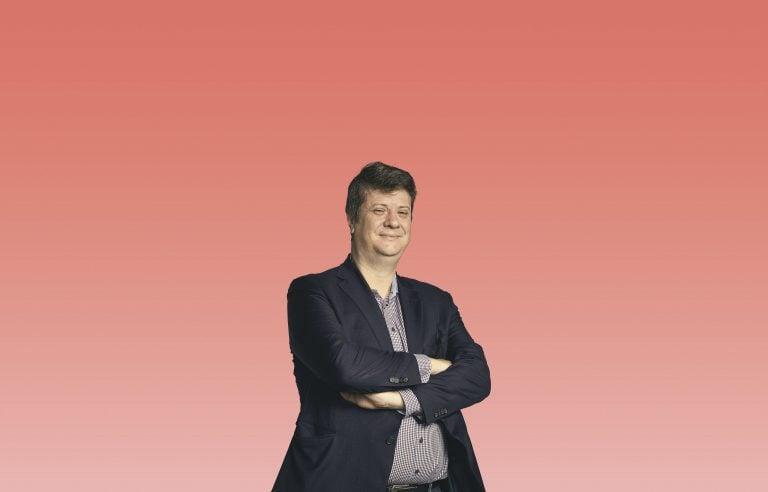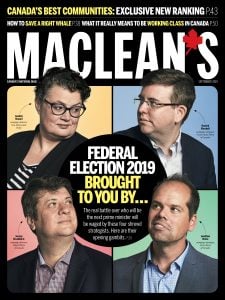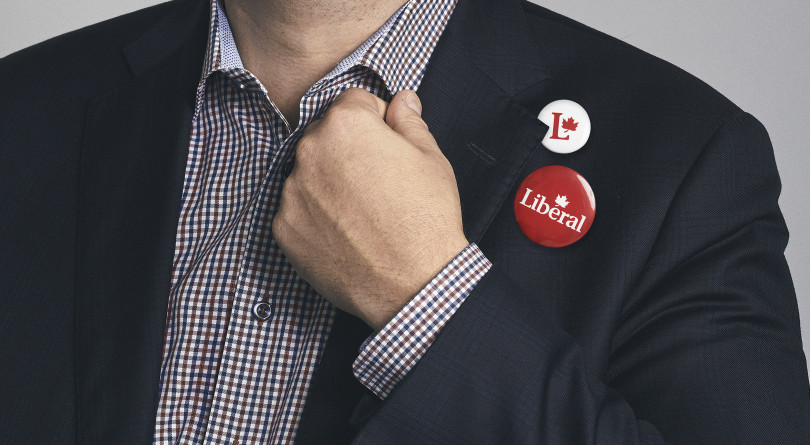How Jeremy Broadhurst plans to get Trudeau re-elected (with help from Gerry Butts)
Jeremy Broadhurst is a Liberal lifer tasked with making sure the Prime Minister gets a second term. Or maybe that’s Gerry Butts.

Jeremy Broadhurst (Photograph by Jessica Deeks)
Share
My assignment was to write about the Liberal campaign director. So I looked at the internet and there was a release from the Liberal Party of Canada from May 1: “Liberals Announce 2019 Campaign Director.” The photo at the top of the release was Jeremy Broadhurst’s. The release featured glowing praise from Justin Trudeau. “Jeremy Broadhurst’s leadership . . . will help us continue to build a 2019 campaign that is innovative, empowering, and competitive in every part of Canada,” the Prime Minister says in the release.
So I emailed the Liberal party office, and soon I was having coffee with Jeremy Broadhurst near Parliament Hill. We talked about his background in Liberal politics (long) and his plans for the fall election campaign.

And then a few days later the CBC’s Aaron Wherry reported that Gerald Butts was returning to the Liberal campaign.
So I’m not really sure what you should make of the rest of this profile. It’s definitely a profile of Jeremy Broadhurst, and it says on the label that he is definitely the Liberal campaign director. But whether Broadhurst can be said to be running the Liberal campaign—well, Butts’s return makes that very much a theological question.
Butts, of course, held none of the fanciest titles in the Liberals’ 2015 campaign. Cyrus Reporter, a lawyer and former chief of staff to Allan Rock, was Trudeau’s chief of staff; Katie Telford, who would have a long future in the Trudeau camp, and Dan Gagnier, who wouldn’t, were its campaign co-chairs. Butts was usually styled a senior adviser or, more accurately and all-encompassingly, as Gerry. But his advice, and the weight Trudeau gave it, made him more senior than just about all the people who did have titles.
CONSERVATIVES: Meet Hamish Marshall, Conservative campaign manager
NDP: Meet Jennifer Howard, NDP campaign manager
GREENS: Meet Jonathan Dickie, Green Party campaign manager
Butts’s resignation as Trudeau’s principal secretary in February of this year, in the early days of the SNC-Lavalin controversy, promptly elevated the whole affair to the level of a political earthquake. His return is a large event whose meaning is uncertain.
Once again, at least for the moment, he has no title, though one senior Liberal said it’s “safe to think of him as a very senior adviser.” He had in fact already been meeting with Broadhurst, in public places, since immediately after Trudeau put Broadhurst in charge of the campaign organization. And now he’s back.
In the meantime, the reporter wrote, retreating as quickly as possible to the world of relative certainty, Jeremy Broadhurst is the Liberals’ 2019 campaign director. Here he was now, in that Parliament Hill coffee shop, having tossed a cigarette away as he arrived. (“He’s a smoker, which isn’t that common any more,” Peter Donolo, the former Jean Chrétien spokesman who promoted Broadhurst when Donolo became Michael Ignatieff’s chief of staff in 2009, told me. “The best time to catch him is outside an event.”)
Broadhurst has been in Ottawa for 20 years. This was our first conversation of any length. A Torontonian by birth, son of an accountant and a piano teacher, the youngest of eight children, he was “a good member of the chorus” at St. Michael’s Choir School who “just always had the bug” when it came to politics.
He was nine during the 1984 election. Brian Mulroney fascinated him. So what made him a Liberal? Well, his father was one. As for ideas, “What got me there was the social-policy stuff. And particularly the Party of the Charter.” His hands carved out an area in space the size of a rugby ball, as though “Party of the Charter” were a brick or another massive object. “At its core it was always that sense of justice and fairness and equality.”
He went to work for Bill Graham, a family acquaintance, taking over the Ontario desk—responsible for files that might affect Ontario, which was a lot of them—when Graham became foreign minister in 2004.
Suddenly Liberal leaders started falling in waves. First Paul Martin quit after losing the 2006 election, and Graham became the interim leader. He kept Broadhurst and a few other staffers on in the suddenly empty leader’s office. “You guys are great,” he told them. “You’re my dollar-a-year men.” They held out for higher pay.
At the end of 2006, Stéphane Dion became the first new Liberal leader who hadn’t been front-runner throughout the leadership campaign. Not having particularly planned to be leader, he had no staff. Broadhurst stayed on, temporarily, and found himself still there when Ignatieff became leader at the end of 2008. By the time Donolo took over to run Ignatieff’s office at the end of 2009, Broadhurst was starting to stand out simply for his ability to survive staff purges.
He became the new new new leader’s director of parliamentary affairs. Stephen Harper was still the prime minister, still with a minority of the seats in the Commons. “One of my tasks was to figure out how to bring down the government.” That turned out to be easier than beating the Conservatives in an election. Broadhurst ran the campaign communications “war room,” to mixed effect at best: Harper handed the Liberals their worst drubbing since Confederation. Bob Rae became the party’s interim leader and Broadhurst, at last, was a chief of staff.
Rae’s comments about Broadhurst are typical of just about any Liberal’s comments about Broadhurst: rave reviews, a bit generic, like book-jacket blurbs. “Jeremy is a terrific guy, calm under pressure, a good sense of humour, and a deep knowledge of the party and its history,” Rae wrote in an email. “He is widely and deeply trusted in the party, and has served ably under many different leaders. I was lucky to have him with me.”
There remained one more leadership change. Justin Trudeau brought a lot of people with him when he swept to the party leadership without effective opposition in 2013, but he actually hadn’t given much thought to who should be the Liberal party’s national director. Broadhurst quickly won the trust of Katie Telford, who would eventually become Trudeau’s chief of staff, so he left life as a political staffer on the Hill and took over the party’s operations.
Like much else in Liberal Ottawa, the party had suffered from a decade with a revolving door. “I’ve often said a party should do two things: win elections, and raise money to win elections,” Broadhurst said. Easier said than done. “If there ever had been a Big Red Machine, it had really died. If we weren’t doing paid phoning, it wasn’t getting done.”
Broadhurst set about integrating data operations and volunteer mobilization: candidates were urged to recruit volunteer armies, which were in turn armed with detailed and up-to-date data about loyal and persuadable voters.

Having played key roles in the 2011 drubbing and the 2015 triumph, Broadhurst is quick to admit that a campaign’s organization can have only so much effect on outcome. Usually it comes down to much more basic considerations: whom do voters trust? But, at the margin, good voter ID can’t hurt. In 2015 it told them Mike Bossio, a telecommunications consultant who was running against a popular Conservative incumbent in Hastings—Lennox and Addington*, was drawing surprising levels of support. It helped that radio stations in the two nearest cities, Belleville and Kingston, were both carrying Liberal ads. Trudeau added Bossio’s riding to his campaign itinerary. Of the 40 ridings Trudeau visited in the campaign’s home stretch, Broadhurst says, the Liberals won 39 (including Bossio’s).
But so much has changed since then. Trudeau ran on change in 2015; now he’s trying to fend it off. He has a record, which means he’s disappointed some of his erstwhile supporters. His brand has been eroded by the SNC mess, by his baffling family trip to India, by his vacation with the Aga Khan, by all the rest.
The general outline of the Liberal pitch is no secret: whereas you get to power by offering hope, you keep it by underlining a contrast, in policy and values, with your main challenger. That makes a re-election campaign a darker, less optimistic thing. Broadhurst summed up the pitch this way: “OK, the train’s left the station, we’ve had some advances, we’ve had some setbacks. But the general direction is good.” The Conservatives, in this frame, want to bring the train back to the station and set it out on some other path. “It’s hard to see that as anything other than a return to Harper-era policies. Which will be very attractive to some people, but we think, to most people, won’t.”
As he did in 2015, campaigning alongside Stephen Harper, Doug Ford will play a prominent campaign role, serving as Justin Trudeau’s favourite object lesson in what happens if you elect Conservatives. The Ontario legislature won’t be sitting during the campaign, but a lot of Ford’s cuts to education and social services will be taking effect, Broadhurst expects. “It’s going to be playing out in real time.”
Broadhurst is the sort of Liberal who used to be common in Ottawa, when leaders’ tenures seemed as long-lasting as geological epochs: a lifer who’s made his career in the capital. The worst decade in the party’s history made Liberal lifers rarer than ever. Whether the species stages a comeback will depend, to a great extent, on whether the campaign works as Broadhurst hopes. Broadhurst and Butts. Butts and Broadhurst. Whatever.
CORRECTION, Aug. 19, 2019: A previous version of this story stated Liberal MP Mike Bossio was elected in Prince Edward County, Ont., in 2015. In fact, he was elected in the riding of Hastings—Lennox and Addington—which had its boundaries redrawn before the election, and no longer included Prince Edward County.
This article appears in print in the September 2019 issue of Maclean’s magazine with the headline, “Next to last man standing.” Subscribe to the monthly print magazine here.